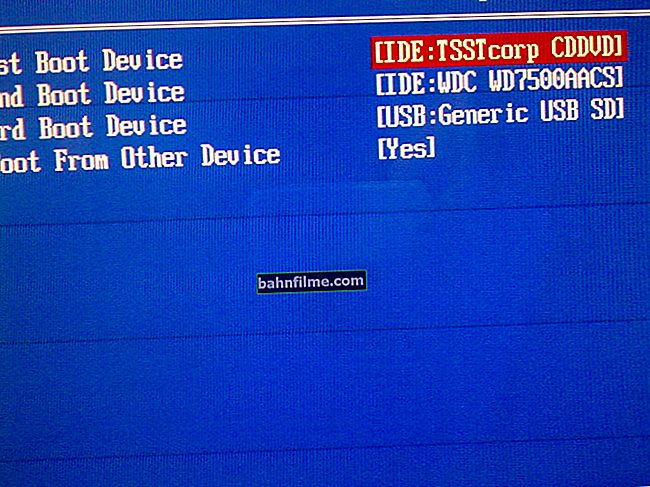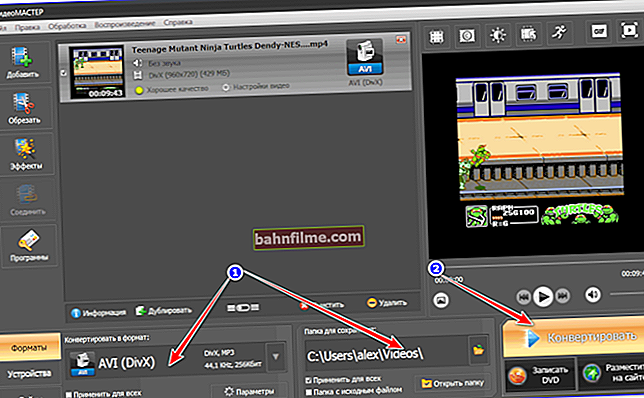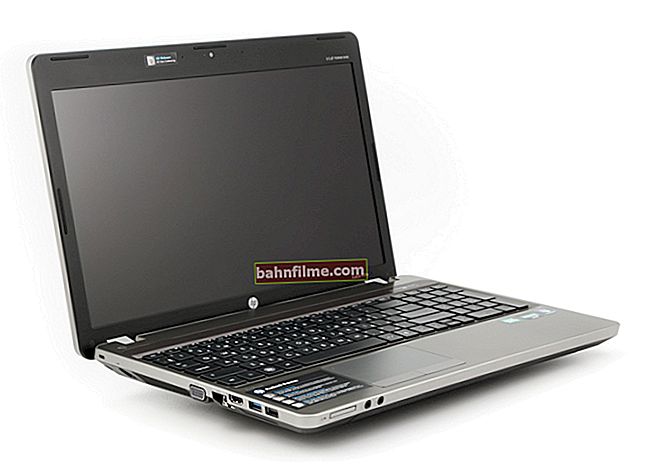 Hello.
Hello.
The rescue of drowning people is the work of the drowning people themselves ...
Unfortunately, it sometimes happens that we, by mistake or unknowingly, delete the required file (s). Often, viruses and various errors become the reason for the loss of information, in the solution of which you have to format the hard drive ...
In general, Windows is a fairly "smart" system, and with the "default" settings, it sends all deleted files to shopping cart (and only after 30 days removes them permanently). In addition, it creates checkpoints for system recovery. Therefore, if you remember about the "loss" in time, the chance of information recovery is quite high.
However, if the desired file is no longer in the recycle bin (for example, you have already cleared it, or more than 30 days have passed and auto-cleared) - do not despair. There is still a chance of recovery! And in this article I will look at what can be done in this case.
So...
*
Instructions for recovering deleted files
Important note!
Before moving on to the recovery steps, I want to point out very important details that you need to know to get started.
How information is deleted
Probably, each of you noticed that copying information to disk takes much longer than deleting it. Why?
The point is that when deleted, physically information from the disk does not disappear anywhere (even after emptying the recycle bin)! It's just that Windows starts to think that the information in such and such sectors on such and such a disk is no longer valuable to the user and can be overwritten!
Thus, the information will actually be deleted only when other data is overwritten in its place! And there are many programs that can scan the drive and find deleted files that have not been overwritten yet.
By the way, fast formatting takes place approximately according to the same principle (and usually no one does full formatting).
About where to install the program for data recovery and where to recover found files
From the above it follows that nothing can be written to the disk on which the data has disappeared! Ideally, it is unnecessary to use it at all, but connect it to another PC and restore data from it.
As a last resort, you can use a flash drive by installing a recovery program on it. Note that you also need to restore deleted files to a USB flash drive or other hard drive! Otherwise, the recovered information may overwrite those files that have not yet been recovered!
Highly desirable do not use utilities to fix various errors on the disk (or format it, even if Windows insists on doing it). At least until you scan his specials. utilities.
Method 1: using file history
If Windows is working and loading for you, then try viewing the file history. The fact is that in most Windows operating systems, the option to create restore points is enabled by default. Not many people know that this also creates copies of some system folders: documents, desktop, etc.
If your missing file was previously in one of the system folders (and many users store their small documents just on the "desktop", or in "my documents" - you should look at the previous versions of the files).
How to do it:
1) Open "This Computer" ("My Computer"), and right-click on the folder you need and select "Properties".
Alternatively, you can simply go to this folder, right-click anywhere in the empty space and select properties.

My computer - open document properties
2) Next, open the "Previous Versions" tab. Now, please note that you may have several folders from different dates in your backup. You will only have to open one by one and see if the file was there.
I note that this method helps not only to return the deleted file, but also to restore the unsuccessfully modified / edited one ...

Previous versions of files - can be opened or restored
3) When you open the saved previous versions of the system folders - you can familiarize yourself with the list of files in them, view and decide on recovery.

Old versions of files!
Important!
If you do not have previous versions of the files, I recommend that you set Windows security settings so that it starts doing them. Below in the article I have described how to set it up.
Trust me, the saved 10-15 GB of hard drive space isn't worth the security of your files ...
Method 2: using special. utilities
And now I want to consider the option of scanning a disk using special. utilities that can find and recover even long-deleted files.
I remind you:
- it is impossible to install such utilities (and download) on the disk from which the information has disappeared! Above in the article I explained why;
- you need to restore the found files to a separate media;
- do not format or fix errors on the drive (which you plan to scan with special utilities) if suddenly Windows offers to do this (for example, as in the case of defining a RAW file system) .
Recommendation!
 I had an article on my blog with the best free programs and utilities for finding and recovering deleted information on your hard drive. You can find the utilities that I will use below in this article.
I had an article on my blog with the best free programs and utilities for finding and recovering deleted information on your hard drive. You can find the utilities that I will use below in this article.
10 free programs for recovering deleted data: files, documents, photos - //ocomp.info/10-programm-dlya-vosstanovleniya-dannyih.html
R.Saver
Official website: //rlab.ru/tools/rsaver.html

An excellent free (for our country) utility designed to recover information from various types of drives: HDD, USB flash drives, MicroSD cards, etc. Supports all popular file systems NTFS, FAT and ExFAT, does not need installation and is 100% translated into Russian.
I also note that it has very good algorithms that allow you to recover information even in cases where many similar utilities are powerless. Actually, that is why I chose her ...
Step by step data recovery
1) To get started, the utility is enough to download and run (moreover, you can download it, for example, on a USB flash drive - which is another plus!). After starting, look through the R.Saver tips, check the boxes and click "Next".

First launch, agree // R.Saver
2) In the next step, specify the drive where the deleted documents were stored.

Selecting the disk on which the documents disappeared
3) Then you will have to wait for the completion of scanning and analysis ...
In general, this procedure is quite lengthy. For example, it took about 1 hour for my 1TB hard drive! At this time, it is better not to interfere with the utility and not run anything else on the PC. The quality of the analysis and the possibility of data recovery directly depend on this.

Analysis and search
4) In the next step, you will see several tabs:
- lost files;
- available files;
- all files (open in my screenshot below).
Moving through the tabs, you can view the files found, mark those that you want to recover. It is convenient that R.Saver sorts all the information it finds into folders: images in one JPG, DOC documents in another, etc.
You have two recovery options:
- you can manually click "Save As" on each file, and then specify where to restore it;
- you can simply check the boxes that you want to restore and at the bottom of the screen click the "Restore Selected" button.

Found files that can be recovered (clickable)
5) Well, and the last step: just specify the final folder where the recovered information will be saved.
Let me remind you that this must not be the physical medium that you scanned and from which you are recovering files.

Save as (convenient for separate single files)

Choosing where to save
MiniTool Power Data Recovery
Website: //www.powerdatarecovery.com/

This utility only allows you to recover 1000 MB for free, but they are worth it! The algorithms of the program are unique and very powerful. In just a few tens of minutes, the program will analyze your drive and offer to recover many more files than analogs.
The utility supports all popular drives: HDD, SSD, flash drives, memory cards, etc. Also knows how to work with file systems: FAT 12/16/32, NTFS (including NTFS5). Note that the utility will help even when removing all partitions from the disk and formatting it (for example, if the OS is not installed skillfully, or a virus attack)!
Step by step work in Power Data Recovery.
1) Download, install, run. Immediately I recommend choosing the option to recover lost photos, media documents, etc. See the screenshot below (this option allows you to perform a deep scan of the disk, which is most effective).

We select the option of deep scanning (search for photos, media, documents, etc.)
2) We indicate the disk on which the files disappeared. Click the "Full Scan" button.

Disk selection
3) Scanning is quite long: it took about 1.5 hours of time on my 1 TB disk. But in principle, any serious scan will take a fair amount of time.

Analysis process (waiting)
4) Next, the utility will present the found files (they will be filtered by folders depending on the format). Opening the JPEG files, I quickly found a few photos that accidentally went to the trash can (and were safely cleaned out of it).
Please note that Power Data Recovery does a good job: a lot of deleted pictures (for example) are displayed perfectly and you can easily view them. It remains only to mark the files that need to be restored by ticking the boxes and press the "Save" button.

Select the files you want to recover
5) Actually, indicate the medium where the files will be restored and wait. Operation completed!

Recovery
How to prevent loss of files
Use Windows protections
First, do not disable them first (the 5-10 GB saved disk space from disabling restore points is not worth it).
And, secondly, check whether they are enabled and whether they work at all.
It's just that in many modern Windows assemblies from "craftsmen", many tools can be disabled (and what is even more sad, in the same Windows 10, not all are enabled by default ...).
What to check?
Press the button combination Win + Pause, in the window that opens with the system properties, click on the link "System protection" (see the example in the screenshot below).

System protection
Next, find the system disk with Windows (it is marked with a sign and has the status "System" on it), and check that it has protection enabled. If not, click the Configure button and enable it.

Configuring system protection
Immediately I recommend creating a restore point (if you did not have one before). To do this, simply click on the "Create" button in this window, specify a name for the point and continue the operation.

Create a restore point
I also recommend turning on the "file history" (this will help you quickly recover the desired document if you accidentally delete it (or viruses spoil it).
To do this, open the Windows control panel, change the display to "Large icons", and click on the link "File history ".

File history
Next, enable file history. Windows will immediately start creating it. I will tell you a very effective tool, despite its underestimation by many users.

File history - turn it on!
After a copy of the files is created, you can always return to it by opening the properties of the system folder (for example, the desktop or my documents, see the screenshot with an example below).

Previous versions of files - can be opened or restored
Use cloud drives
Now in Windows, you can connect a cloud drive in 2-3 mouse clicks (I'm not talking about the fact that in the same Windows 10 there is already a pre-installed OneDrive).
Remark!
 Cloud storage: what, how, why? How to connect a cloud drive to Windows, Android - secure storage of files in the cloud, available anytime, anywhere - //ocomp.info/kak-podklyuchit-oblachnyiy-disk.html
Cloud storage: what, how, why? How to connect a cloud drive to Windows, Android - secure storage of files in the cloud, available anytime, anywhere - //ocomp.info/kak-podklyuchit-oblachnyiy-disk.html
Using such a "cloud" is very simple. For example, after installing Yandex disk, a special appears in the explorer. a link to the Yandex Disk folder, which is automatically synchronized with the cloud.
Thus, it is enough to keep your documents in it, and they will be automatically saved not only on your disk, but also on Yandex servers.

Yandex Disk - Synchronization between your phone, PC, and cloud disk!
As for OneDrive, by activating your account and going into the settings, you can specify which folders you want to sync. For example, I have it "My Documents" and "Desktop". Thus, I do not even think about the fact that something may be missing somewhere. See screenshots below.

Selecting folders to sync

Folders are stored both on the PC hard drive and in the cloud
Make backups
This is probably the most important message for everyone. It is highly advisable to throw your documents on removable media at least once a week. But many will argue, are there clouds? I will add ...
What if you need documents, and the Internet will temporarily not work for you? Or another option - the required document will disappear from the hard drive, and the information will not have time to synchronize with the cloud? In my opinion, it's still better to play it safe. Moreover, I do not think that most users have tens of gigabytes of important documents to make this operation time-consuming ...

By the way, if you want to set up an automatic backup of at least the entire disk, I recommend that you read this article: //ocomp.info/kak-sdelat-bekap-diska-dokov.html
*
That's all...
Happy recovery to everyone!









